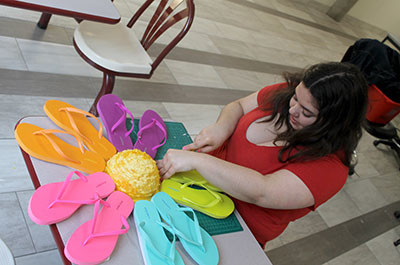BY COURTNEY BLOK
PHOTOS BY COURTNEY BLOK
Life is better in flip-flops.
When first-year Visual Merchandising students Chelsea Kumar and Laura Katergos were partnered to create a window display in the B-Wing, they knew they wanted to do something that would stand out. Budding flowers and bright skies inspired them.
“We wanted to do something different. We thought the other students would probably do purses or perfumes, so we decided to do Old Navy flip-flops,” said Kumar.
Their task was to create a spring-themed window, showing off an accessory for a brand while using “cling” on their window. Window cling is made from a flexible plastic that serves as a temporary method for covering windows.
This is what they used to put the Old Navy logo and their slogan on the window. They also weren’t allowed to use side panels to cover up the sides of their windows.
“This adds another challenge as we have to worry about the visual appearance of more angles,” said Kumar.
Weeks of preparation go into building the visual merchandising windows. From planning and designing the windows, to ordering the cling and purchasing the products.
Kumar and Katergos met up the night before to get everything ready for the window set up on April 7.
While Katergos was getting the flip-flops from Old Navy, Kumar searched the dollar store for materials they could use to create their vision.
“We didn’t want to just display the flip-flops normally, so we decided to make them in the shape of a flower,” said Katergos. “We felt as if it was something Old Navy would do.”
What appear to be random objects are materials that fit their vision for their window. Kumar uses a Styrofoam ball, pieces of felt and some yarn to create the middle of the flip-flop flower. It is difficult to imagine at first, but once she gets back to the studio, she tries out different techniques.
Kumar finally decides that the middle of the flower would work best cut in half. She uses double-sided tape and the textured yarn to replicate pollen.
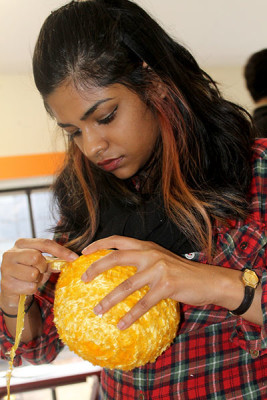
“It’s kind of trial and error thing,” Kumar explains as she works with the materials. “The thing about double-sided tape is that it can melt in the window. So, it’s a not a sure thing.”
Before Katergos starts working on the flip-flop flower itself, they have to decide what flip-flops colours they should use.
They scatter the rainbow-coloured flip-flops across the table, and start to figure out what colours pop the most and how many they should use, depending on the size of the flower. The materials they’ve bought are purchased out of their own pocket.
The products can normally be returned, but art supplies such as foamcore and the yarn can’t.
“We are lucky because this is a small window,” said Kumar. “We maybe spent $20, not counting the cling. Ours was definitely a cheaper design.”
The cling cost them an additional $17.
While Kumar works on creating the centre of the flower, Katergos cuts out the foamcore, which is used to reinforce the flip-flips. The girls also settle on using foamcore as the stem and leaf of the flower, as well as the clouds.
They add the cotton balls to the cloud to give it the fluffy effect. They then cut out green fabric and wrap it around the foamcore to make the stem and leaf.
The next day at 11 a.m., they meet to finally put their window together, but before they start anything they need to put on their cling. The cling orders are nowhere in sight.
With a set timeframe, the girls grow worried and decide they could probably put the fake grass in before the cling.
“This is what the industry is like. Something can always go wrong, and you just have to learn to work around it,” said Katergos.
The girls are lucky because the cling they have chosen for their window is very minimal and small, so they decide they can continue to build most of their window without it and work around their display once it comes.
So they start suspending the flower with fishing line and dress pins to make it stand up. They try to make sure that the fishing line can’t be seen so it doesn’t take away the illusion of the window.
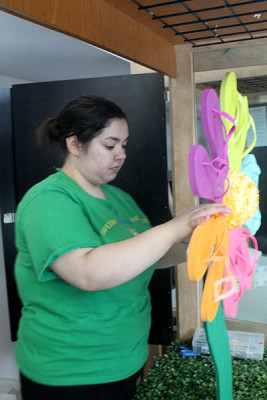
“Every detail matters, because it’s the small details that we get marked on,” said Katergos.
Kumar admits that she finds this the trickiest part of the window because it’s something you can’t plan ahead of time.
“I think the hardest part about building it is when you do things where you actually need the window physically,” said Kumar. “Each window is actually different and the hard part is not knowing what the actual outcome is going to be. You’re picturing something that maybe doesn’t translate in person.”
After making sure the placement and support for their window is good, they head back to the studio to see if the cling has come in. The cling arrives around 2:30 p.m.
They make their way back to their window to add the finishing touches. Kumar climbs in the window, trying not to touch any of the display in order to place the cling. First she wets the window, and then slowly places the cling across the window.
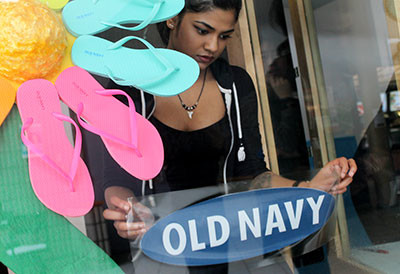
Katergos stands on the other side of the window to let Kumar know if it lines up the way they want it. With the cling on the window, they can finally breathe.
All they have left to do is add the clouds, make sure the lighting is focused on the flower, and complete it with the blue backdrop.
At 4:30 p.m., the window is complete. They can call it a day.
“My favourite thing is when it is actually done and I get to see how it turned out,” said Katergos. “I’m happy with the results of this one.”
Visual Merchandising is one of few programs where class projects are displayed for the entire school to view.
“To actually see your hard work and effort, and see other people’s opinions on your window,” said Kumar. “That is the best part of it.”
As soon as the window is finished, passing students are already taking notice. The windows make their way into a lot of conversations around campus.
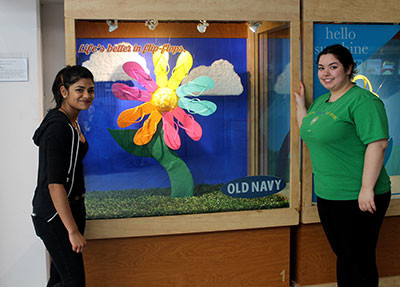
“When people hear ‘visual merchandising,’ they automatically think of display windows, but it’s not just display windows,” said Kumar. “You can break off into home décor, set design, fabrication, prop making. It’s a very diverse program and I like being not just a one trick pony.”
Katergos hopes to go into home décor or set design as a future career, while Kumar is still weighing her options.

